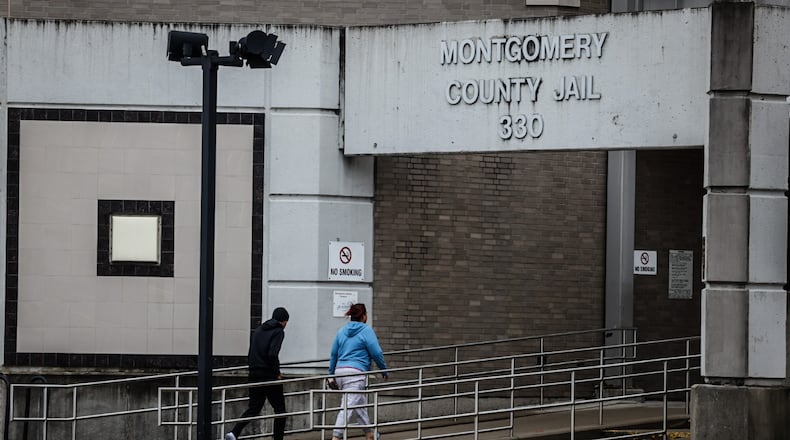The number of deaths in the jail is “deeply alarming,” said Joel Pruce, a University of Dayton professor and coordinator with the Montgomery County Jail Coalition.
“It raises a lot of red flags, in terms of whether or not the Montgomery County Jail is equipped to prevent people from dying in their custody,” he said.
Three of the four deceased were being treated at a local hospital at the time of their death, said Montgomery County Sheriff Media Director Christine Bevins. The coroner’s office handles all death notifications, Bevins told this news outlet.
“This is a clear spike in drug-related deaths parallel to the community,” Bevins said Friday.
According to data from Montgomery County Public Health’s Community Overdose Action Team, overdose deaths were up by 39% in January this year and by 30% in February, compared to those same months in 2022.
According a February statement from the Montgomery County Coroner’s Office, Xylazine was found in 15 suspected overdose deaths in January this year. Xylazine is used to cut fentanyl, and is Narcan-resistant.
“This coincides with our experiences inside the jail with our staff and medical provider administering Narcan to newly arrested inmates at a higher rate than ever before,” Bevins said.
In 2022, jail staff administered Narcan on 34 occasions, but have already dispensed 19 to date in 2023, she said.
Credit: JIM NOELKER
Credit: JIM NOELKER
Four dead in 2023
Steven D. Blackshear, 54, of Dayton, was booked into the jail Jan. 26 and awaiting trial for misdemeanor theft. He died Jan. 29. The coroner’s office said the cause was “intoxication by fentanyl. Atherosclerotic and hypertensive cardiovascular disease were contributing conditions.”
Aaron Dixon, 52, who was being held on drug charges since Jan. 9, died on Jan. 13. The coroner’s office said the cause was “Fentanyl and buprenorphine intoxication.”
Amber Goonan, 41, was arrested on charges of drug possession and booked into the jail on Feb. 19. She died on Feb. 24 of “multiple drug intoxication” including fentanyl, fluorofentanyl, and others, according to the coroner’s office, with bronchopneumonia as a contributing factor.
19-year-old Isaiah Trammell was arrested on charges of domestic violence on Mar. 13, and died Mar. 16. His cause of death is still pending, per the coroner’s office.
Stopping drugs at the jail
The Montgomery County Sheriff’s Office uses body scanners and K9 dogs to keep drugs out of the jail, as well as scanning and presenting all mail electronically to inmates. Visitations are also done by kiosk or iPad, with no face-to-face visits. All of these are methods to deter drugs from entering the facility.
But members of the community are wondering if it’s enough.
“It could be staff is not equipped to deal with either the inmates coming in that are on drugs, or that are already on medicine,” said Denise Henton of the Montgomery County Jail Coalition. “Or it is simple neglect.”
Credit: JIM NOELKER
Credit: JIM NOELKER
Other deaths in previous years at the Montgomery County Jail and other area jails and prisons included suicide or physical violence, per the coroner’s office.
“How drugs get in the jail is one component of the broader picture here,” Pruce said. “You go back years on the data and it’s not just drugs either. It’s suicide, it’s violence. And that’s only taking the data at face value.”
The Montgomery County Jail currently is near its lowest daily average populations post-COVID, Bevins said.
Medical care at the jail
But she said the jail is seeing an increase in arrestees with significant mental health and addiction issues, prompting increased treatment and subsequent costs.
“We currently do everything we can, based on best practices, training, and technology to deter and detect narcotics from entering the facility, Bevins said. “Keep in mind, the facility was built in the early 1960s to detain a population that did not have the medical, mental health and drug treatment needs that we see today.”
Detectives from MCSO’s Special Investigations Unit and its Inspectional Services Unit investigate all next of kin in regard to custody deaths.
Record keeping on medical treatment of inmates is handled by jail medical staff, Bevins said.
All inmates are examined by medical professionals with NaphCare — the company with whom MCSO contracted to handle medical needs in the jail — when booked in and receive treatment as needed either on site by NaphCare, or from community providers. MCSO’s contract with NaphCare is for 46 full-time medical staff who provide care around the clock, she said.
Protocols are in place for inmates needing medical treatment in the jail. On any given day more than 50% of the jail’s inmates have chronic medical conditions, more than half are on medication and one fourth or more of them are on mental health medications, Bevins said.
All in-custody deaths are reviewed by jail administration and the jail healthcare team, which includes doctors, physician assistants and nurse practitioners, she said.
“The same teams also meet routinely to discuss other critical incidents and high-risk patients,” Bevins said. “If protocol changes are identified, they are implemented.”
Credit: JIM NOELKER
Credit: JIM NOELKER





